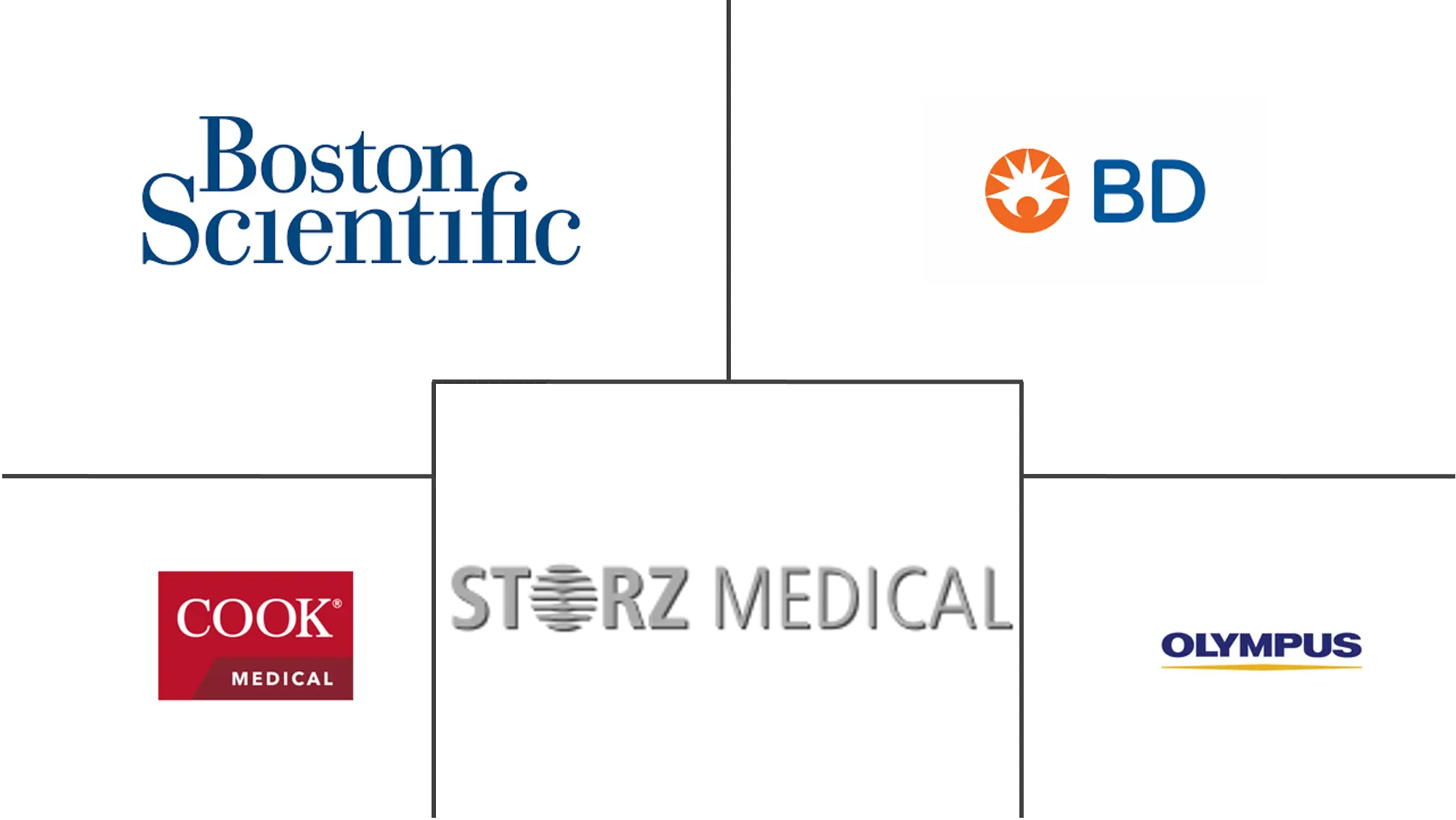Kidney Stone Retrieval Devices Market Size and Share
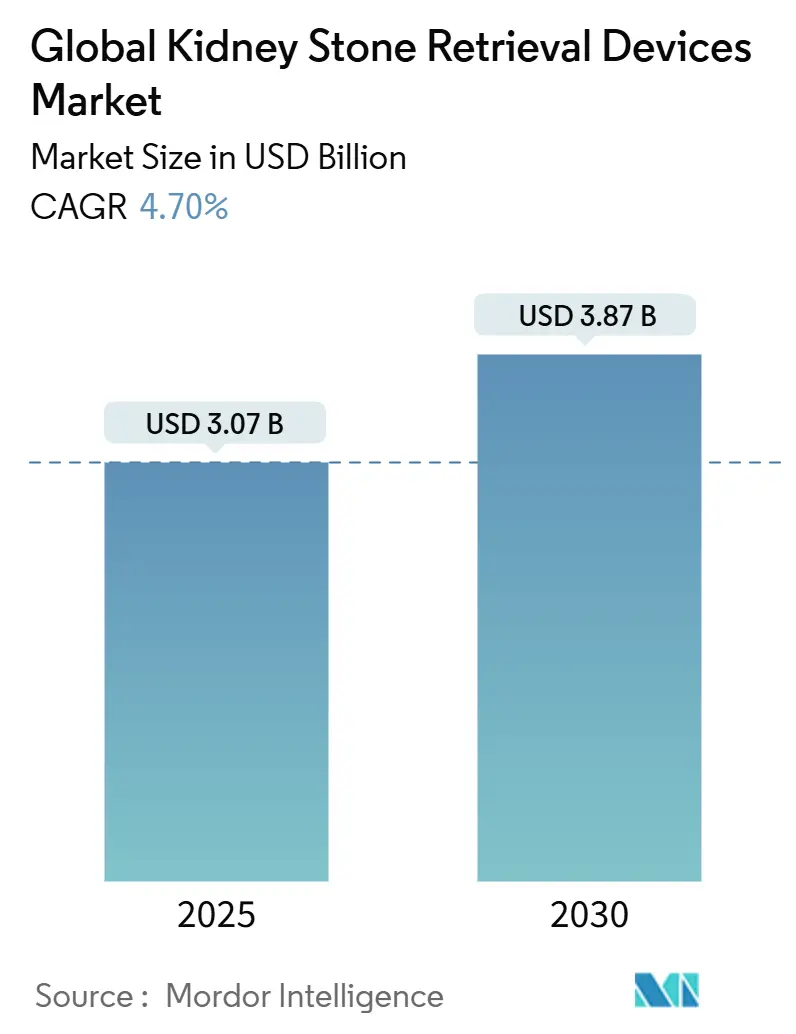
Kidney Stone Retrieval Devices Market Analysis by Mordor Intelligence
The kidney stone retrieval devices market stood at USD 3.07 billion in 2025 and is projected to reach USD 3.87 billion by 2030, advancing at a 4.7% CAGR during the forecast period. Sustained momentum in the kidney stone retrieval devices market arises from the climbing incidence of urolithiasis in ageing populations, the ongoing shift toward minimally-invasive treatment pathways, and the swift roll-out of single-use flexible ureteroscopes, thulium-fiber lasers, and other purpose-built retrieval accessories. Broader reimbursement—illustrated by CMS transitional pass-through payments for single-use scopes—reduces economic barriers, while outpatient centers capture a rising proportion of routine stone procedure. Competitive intensity in the kidney stone retrieval devices market stays moderate as Boston Scientific, Olympus Corporation, Cook Medical, and other leaders combine hardware innovation, physician training, and geographic expansion to widen procedural reach. Cost headwinds linked to premium digital scopes and volatile nitinol supply chains persist, yet cost-effective single-use options and steadily improving reimbursement dilute downside risk.
Key Report Takeaways
- By device type, ureteroscopes led with 34.45% of the kidney stone retrieval devices market share in 2024, while lithotripters are forecast to expand at a 5.34% CAGR through 2030.
- By end-user, hospitals commanded 62.34% share of the kidney stone retrieval devices market size in 2024; ambulatory surgical centers are advancing at a 6.34% CAGR through 2030.
- By geography, North America held 42.56% of the kidney stone retrieval devices market share in 2024, whereas Asia-Pacific is projected to grow the fastest at 7.12% CAGR to 2030.
Global Kidney Stone Retrieval Devices Market Trends and Insights
Driver Impact Analysis
| Driver | (~) % Impact on CAGR Forecast | Geographic Relevance | Impact Timeline |
|---|---|---|---|
| Shift toward single-use flexible ureteroscopes | +1.2% | North America and Europe, expanding globally | Medium term (2-4 years) |
| Growing prevalence of urolithiasis in ageing populations | +0.9% | Especially Asia-Pacific | Long term (≥ 4 years) |
| Wider reimbursement for minimally-invasive procedures | +0.8% | North America and EU core; widening in APAC | Medium term (2-4 years) |
| Rapid adoption of thulium-fiber and burst-wave lithotripsy | +0.7% | Developed markets first | Short term (≤ 2 years) |
| AI-assisted endoscopic navigation reducing OR time | +0.5% | Early pilots in North America and Europe | Medium term (2-4 years) |
| ESG pressure favoring low-water, low-radiation techniques | +0.3% | Initially EU; gradually worldwide | Long term (≥ 4 years) |
| Source: Mordor Intelligence | |||
Shift toward single-use flexible ureteroscopes
Clinical evidence shows that single-use scopes remove reprocessing costs, cut cross-contamination risk, and deliver comparable stone-free outcomes to reusable equivalents. Per-case expenditure ranges from USD 1,300–3,180, making them economical for facilities handling fewer than 50 cases annually. Boston Scientific’s LithoVue platform spearheads adoption, while Olympus will introduce its first single-use ureteroscope in Europe in H2 FY2025. CMS transitional pass-through payments under code C1747 bolster the kidney stone retrieval devices market by improving outpatient economics.
Wider reimbursement for minimally-invasive procedures
Medicare recognizes ureteroscopic lithotripsy as reasonable and necessary, and CMS recently assigned Category I CPT codes to Olympus’s iTind system, signaling willingness to remunerate validated innovation[1]Source: Centers for Medicare & Medicaid Services, “National Coverage Determination for Kidney Stone Treatment,” cms.gov. Field reimbursement managers and ROI calculators from Boston Scientific help providers navigate billing, smoothing adoption paths in the kidney stone retrieval devices market .
Rapid adoption of thulium-fiber and burst-wave lithotripsy
Thulium-fiber lasers shorten operative time by 20% and save USD 69 per case versus holmium:YAG systems. Japanese case series recorded basketing times of 7 minutes compared with 21 minutes for legacy lasers while maintaining equal stone-free rates. Compact consoles needing only standard outlets suit smaller clinics and expand the kidney stone retrieval devices market.
AI-assisted endoscopic navigation reducing OR time
More than 69 studies highlight AI benefits in stone recognition and outcome prediction. Early robotic flexible ureteroscopy platforms achieved 93.48% stone-free rates for stones <4 mm in initial clinical use. AI-ready optics increase differentiation inside the kidney stone retrieval devices market, yet regional data-governance gaps and uneven digital literacy slow mainstreaming[2]Source: APACMed, “Realizing the Value of AI in MedTech within Asia Pacific,” apacmed.org.
Restraint Impact Analysis
| Restraint | (~) % Impact on CAGR Forecast | Geographic Relevance | Impact Timeline |
|---|---|---|---|
| High capital cost of digital ureteroscopes | -0.8% | Global; steeper in emerging markets | Medium term (2-4 years) |
| Device-related infection and encrustation risk | -0.6% | Global with variable oversight | Short term (≤ 2 years) |
| Shortage of endourology specialists | -0.5% | Low- to middle-income nations, rural zones | Long term (≥ 4 years) |
| Supply-chain dependence on nitinol | -0.4% | Concentrated supplier base worldwide | Medium term (2-4 years) |
| Source: Mordor Intelligence | |||
High capital cost of digital ureteroscopes
Reusable flexible scopes cost USD 50,000–150,000 and require supporting lasers and imaging stacks exceeding USD 200,000, delaying ROI for resource-constrained sites. Single-use scopes shift cost to operating budgets but can top USD 3,000 per case at low volume, complicating procurement decisions in the kidney stone retrieval devices market.
Device-related infection and encrustation risk
Stent encrustation risk rises after prolonged dwell times, sometimes demanding secondary surgeries. The FDA issued a class I recall on a renal-aspiration system in 2025, underscoring regulatory vigilance in the kidney stone retrieval devices market.
Segment Analysis
By Device Type: Ureteroscopes Extend Their Lead
The ureteroscope segment accounted for 34.45% of the kidney stone retrieval devices market share in 2024, which translated to roughly USD 1.06 billion of the 2025 kidney stone retrieval devices market size. Dominance stems from the instrument's essential role in visualising and accessing calculi throughout the urinary tract, while recent upgrades in digital imaging and smaller outer diameters improve manoeuvrability and patient safety. Single-use digital ureteroscopes accelerate volume growth because hospitals can eliminate repair downtime, reprocessing expense and cross-contamination risk. Reusable fleets remain relevant in high-volume academic centres that can amortise reprocessing infrastructure and secure multiyear service contracts. Retrieval baskets and guidewires move in parallel since every ureteroscopic case requires at least one ancillary tool for fragment extraction or device placement.
Lithotripters represent the fastest-growing device class with a projected 5.34% CAGR to 2030, led by thulium-fibre laser consoles that deliver faster fragmentation with lower retropulsion than holmium:YAG systems. Compact footprint, standard-outlet power requirements and embedded safety controls allow smaller ambulatory sites to adopt high-energy lasers that once belonged only in tertiary theatres. Access sheaths with suction ports shorten operative time by lowering intrarenal pressure and clearing debris in real time, a benefit that dovetails with advanced laser performance. Manufacturers are layering artificial-intelligence algorithms on top of digital video streams to automate stone detection and propose optimal laser settings, adding another point of differentiation in the kidney stone retrieval devices market. Environmental sustainability also shapes buying criteria; vendors now highlight recyclable packaging and lower water consumption during scope cleaning to align with hospital ESG goals.
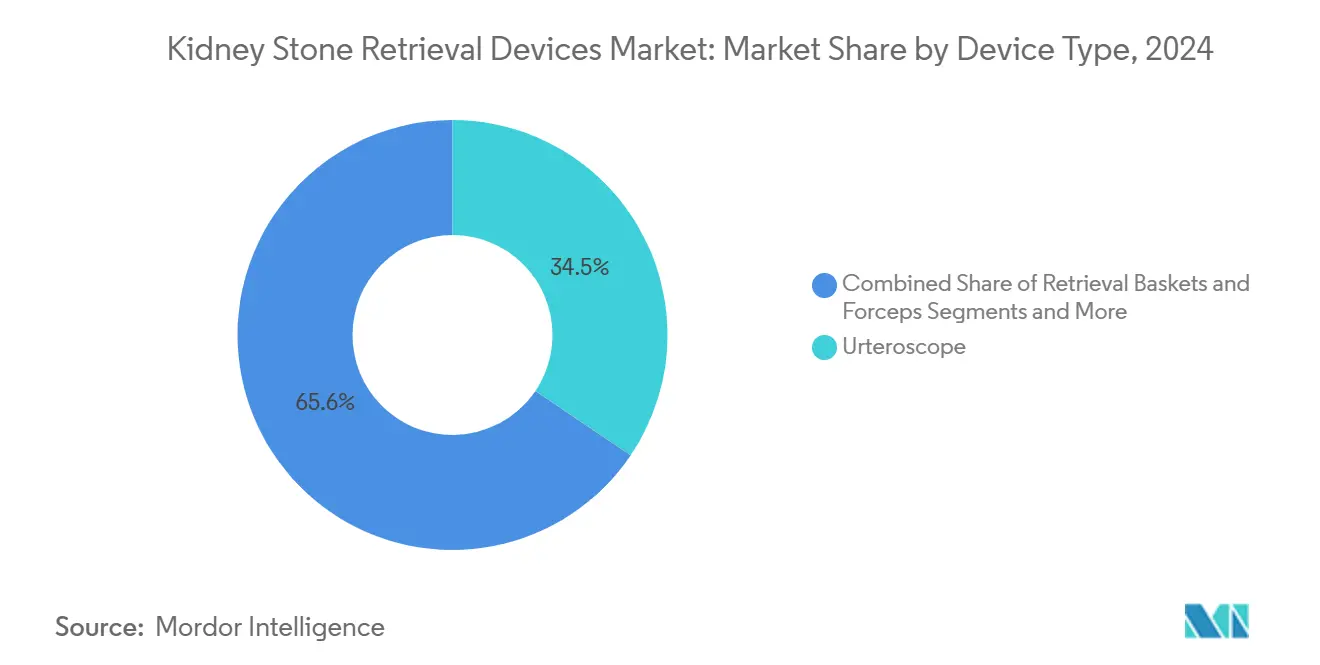
Note: Segment shares of all individual segments available upon report purchase
By End-User: Hospitals Anchor Demand while Ambulatory Centres Accelerate
Hospitals generated 62.34% of the kidney stone retrieval devices market size in 2025, or around USD 1.91 billion, thanks to 24/7 capability, multidisciplinary backup and access to capital for premium optics. Emergency departments funnel acute renal-colic cases directly into surgical suites, underpinning steady baseline volumes. Academic centres also serve as early adopters of AI-ready scopes and simulation tools, influencing regional referral patterns. Budget committees increasingly scrutinise total cost of ownership, leading many systems to deploy mixed fleets: reusable scopes for predictable high-volume lists and single-use models for infectious or anatomically complex cases. Vendor service bundles that combine training, predictive maintenance and data dashboards help hospitals optimise asset utilisation and justify capital expense.
Ambulatory surgical centres (ASCs) are the fastest-growing channel with a 6.34% CAGR to 2030, propelled by CMS transitional pass-through payments that offset disposable scope costs and align reimbursement with outpatient economics. Same-day discharge, flexible scheduling and lower facility fees appeal to payers and patients alike, shifting straightforward sub-2 cm stones away from inpatient settings. ASCs favour single-use scopes because the devices remove the need for costly reprocessing rooms and biofilm-monitoring protocols. Specialty urology clinics move in a similar direction, often leveraging group-purchasing contracts or mobile laser-rental services to control overhead. The migration of routine procedures to outpatient venues broadens geographic access, fosters price competition and cements the kidney stone retrieval devices market as an integral component of value-based care pathways.
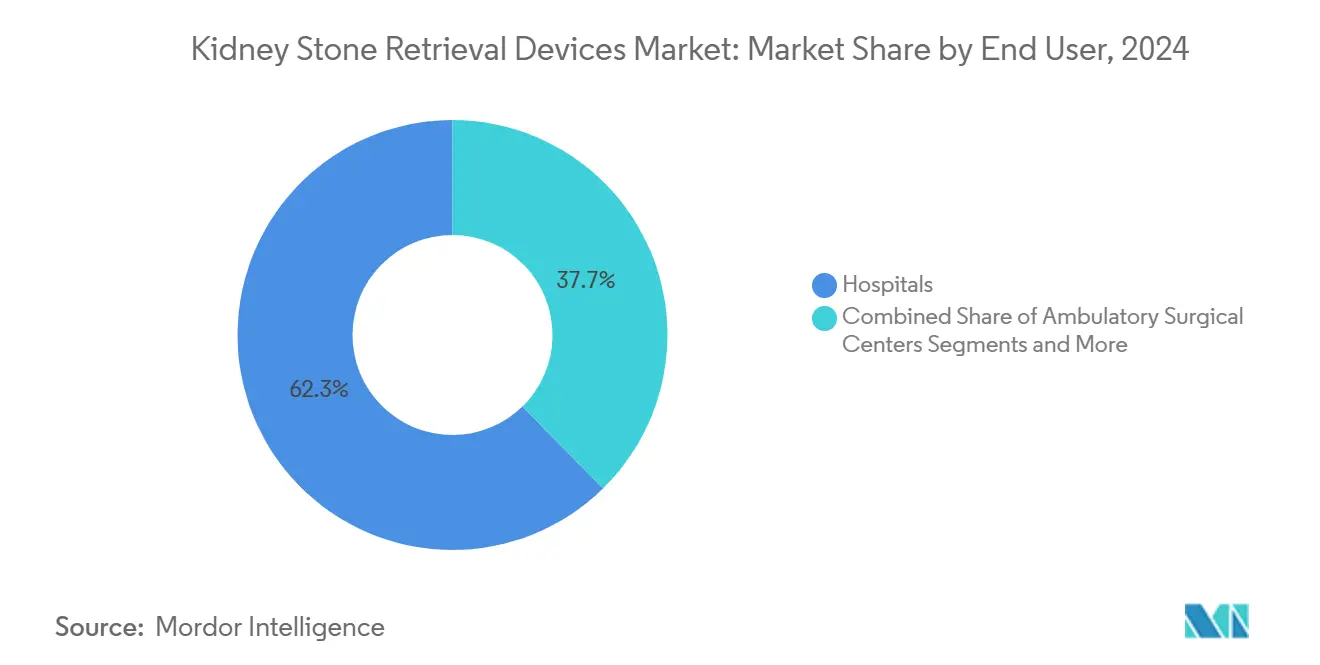
Note: Segment shares of all individual segments available upon report purchase
Geography Analysis
North America controlled 42.56 % of the kidney stone retrieval devices market in 2024, buoyed by comprehensive payer coverage and high surgeon density. Medicare reimbursement for transurethral lithotripsy and CMS pass-through payments for single-use scopes solidify procedural economics. Boston Scientific reported 23.5 % Urology segment growth in Q1 2025 as hospitals and ASCs upgraded to digital single-use platforms. Canada mirrors this trend under provincial funding, although capital constraints lengthen purchasing cycles for AI-ready consoles.
Asia-Pacific represents the fastest-growing region, expanding at a 7.12 % CAGR through 2030. Rising prevalence, urbanisation and improving insurance penetration fuel procedure volumes. China's national data show a decisive tilt toward ureteroscopic treatment; Japan leads in thulium-fiber laser utilisation, and India's private-insurance growth unlocks demand for cost-effective single-use scopes. Governments pursue Access-Capability-Trust frameworks to harmonise device approvals, upskill surgeons and build digital infrastructure—steps vital for sustained expansion of the kidney stone retrieval devices market.
Europe exhibits steady growth, supported by Medical Device Regulation compliance and ESG-weighted procurement criteria. Olympus is set to launch its first single-use ureteroscope in H2 FY2025, catering to hospitals aiming to reduce cross-infection and water consumption. Recent surveys indicate a decline in the Simulator Availability Index for ureteroscopy trainers, signalling potential workforce bottlenecks. South America and the Middle East participate through technology-transfer partnerships, whereas Africa faces financing hurdles and remains an untapped frontier of the kidney stone retrieval devices market.
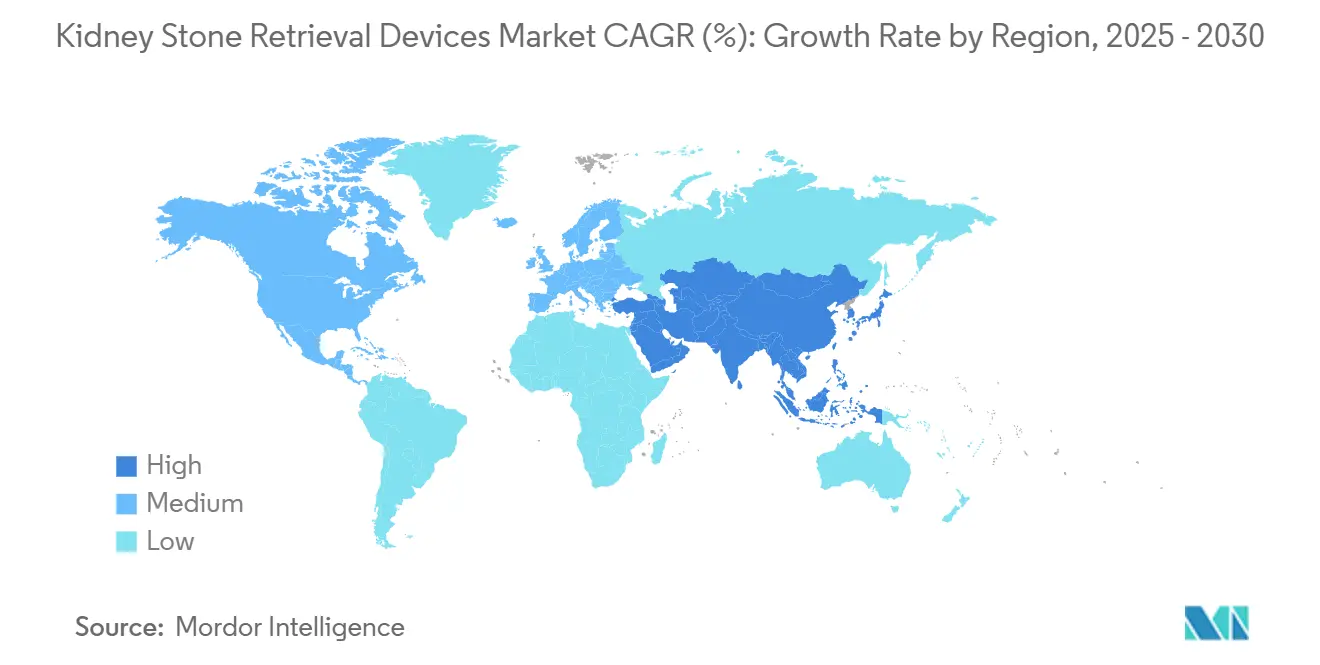
Competitive Landscape
The kidney stone retrieval devices market is moderately consolidated. Boston Scientific commands leadership with its LithoVue single-use digital ureteroscope, reinforced by robust reimbursement support and data-monitoring tools. Olympus follows with its SOLTIVE SuperPulsed Laser and forthcoming single-use scope. Cook Medical, KARL STORZ and Dornier MedTech complete the leading cohort, each supplying complementary products—access sheaths, imaging towers, or shock-wave systems.
Strategic deals illustrate dynamic competition. Teleflex’s EUR 760 million acquisition of BIOTRONIK’s vascular-intervention assets widens its catheter-based therapeutic arsenal . KARL STORZ’s proposal to purchase robotic-surgery firm Asensus underscores growing interest in flexible robotics and AI integration. Emerging players such as Calyxo and EndoTheia pursue niche differentiation—continuous-aspiration evacuation and steerable stone baskets respectively—offering hospitals new avenues to boost stone-free results
Beyond hardware, vendors vie in sustainability credentials, training ecosystems and digital-analytics services. Initiatives range from carbon-neutral manufacturing roadmaps to cloud dashboards that benchmark scope utilisation—features increasingly decisive in tender evaluations inside the kidney stone retrieval devices market.
Kidney Stone Retrieval Devices Industry Leaders
-
Boston Scientific Corporation
-
Becton, Dickinson and Company
-
Cook Medical
-
Olympus
-
STORZ MEDICAL AG
- *Disclaimer: Major Players sorted in no particular order

Recent Industry Developments
- February 2025: Teleflex agreed to acquire BIOTRONIK’s Vascular Intervention business for approximately €760 million, expanding its interventional portfolio
- December 2024: Calyxo’s ASPIRE trial showed 97 % stone clearance with the CVAC System versus 93 % for standard ureteroscopy
- November 2024: EndoTheia completed FlexStone trials, enlarging options for difficult stone retrieval
Research Methodology Framework and Report Scope
Market Definitions and Key Coverage
Mordor Intelligence defines the kidney stone retrieval devices market as all disposable and reusable instruments that locate, fragment, or extract calculi from the urinary tract, namely flexible and semi-rigid ureteroscopes, retrieval baskets and forceps, lithotripters (laser, ESWL and burst-wave), ureteral stents, dilators, access sheaths and guidewires.
Home-use hydration aids, oral chemolytic drugs and diagnostic imaging equipment remain outside scope.
Segmentation Overview
- By Device Type
- Ureteroscopes
- Retrieval Baskets & Forceps
- Lithotripters
- Ureteral Stents
- Dilators & Access Sheaths
- Guidewires
- By End-user
- Hospitals
- Ambulatory Surgical Centers
- Specialty & Urology Clinics
- By Geography
- North America
- United States
- Canada
- Mexico
- Europe
- Germany
- United Kingdom
- France
- Italy
- Spain
- Rest of Europe
- Asia-Pacific
- China
- Japan
- India
- South Korea
- Australia
- Rest of Asia-Pacific
- South America
- Brazil
- Argentina
- Rest of South America
- Middle East and Africa
- GCC
- South Africa
- Rest of Middle East & Africa
- North America
Detailed Research Methodology and Data Validation
Primary Research
We validate secondary findings through structured calls and short surveys with practicing urologists, procurement heads at hospitals and ASC chain managers across North America, Europe, Asia-Pacific and the Gulf. Discussions clarify adoption of single-use scopes, typical ASP ranges, and regional reimbursement nuances, which helps us fine-tune market splits and forecast drivers.
Desk Research
Our analysts begin with open datasets that map the burden of urolithiasis, such as the Global Health Observatory, the National Kidney Foundation's prevalence surveys, Eurostat hospital-discharge files and the CDC's National Inpatient Sample, and then link them to procedure volumes released by bodies like the American Urological Association and EAU. Device trade flows from UN Comtrade, 10-K filings, and recall notices on the FDA MAUDE database reveal shipment direction, average unit values and technology shifts. For competitive signals, we screen Dow Jones Factiva and patent families via Questel. These illustrations are not exhaustive; several additional public and subscription sources support each data point.
Market-Sizing & Forecasting
We apply a top-down build that converts incidence of symptomatic stones into treated-case pools, adjusts for therapy mix (ESWL, URS, PCNL) and multiplies by region-specific device utilization rates. Selective bottom-up checks, supplier revenue roll-ups and sampled ASP × volume, calibrate totals. Key variables in our model include: 1) prevalence of kidney stones per 100,000 adults, 2) annual ureteroscopy procedures, 3) share of single-use scopes in URS, 4) ASP deflation for laser fibers, and 5) reimbursement code revisions that influence stent demand. Five-year forecasts are produced through multivariate regression on demographics, obesity rates and capital-budget trends, with scenario analysis overlaying guideline changes. Where bottom-up data run thin, gap-filling follows weighted averages from peer regions and confirmed expert ranges.
Data Validation & Update Cycle
Outputs pass variance checks against independent procedure registries, then move to a two-level analyst review. We refresh every twelve months and trigger interim updates after material events, for example, FDA clearance of a novel burst-wave lithotripter. A final pre-publication sweep ensures clients receive our most current view.
Why Mordor's Kidney Stone Retrieval Devices Baseline Earns Reliability
Published values differ because firms choose contrasting scopes, assumptions and refresh rhythms.
Key gap drivers revolve around whether disposable scopes are counted, how ASP erosion is modeled, and the timeframe each publisher last updated.
Benchmark comparison
| Market Size | Anonymized source | Primary gap driver |
|---|---|---|
| USD 3.07 B (2025) | Mordor Intelligence | - |
| USD 2.84 B (2024) | Regional Consultancy A | excludes single-use ureteroscopes; uses 2022 procedure ratios without update |
| USD 2.75 B (2022) | Global Consultancy A | relies on manufacturer revenue only; limited hospital sample, no ASP erosion factor |
| USD 3.66 B (2024) | Industry Association B | bundles post-operative stent sales and ancillary infusion pumps, inflating total |
Taken together, the comparison shows that Mordor's disciplined scope selection, yearly refresh and dual-path (top-down-bottom-up) validation create a balanced, transparent baseline that decision-makers can reproduce and stress-test with minimal additional data.
Key Questions Answered in the Report
What is the current kidney stone retrieval devices market size?
The kidney stone retrieval devices market size reached USD 3.07 billion in 2025 and is forecast to grow to USD 3.87 billion by 2030.
Which procedure dominates global stone-removal volumes?
Ureteroscopic lithotripsy dominates, owing to its minimally-invasive nature, high stone-clearance rates and short recovery times.
Why are ambulatory surgical centers expanding fast?
Asia Pacific is estimated to grow at the highest CAGR over the forecast period (2025-2030).
Which region has the biggest share in Global Kidney Stone Retrieval Devices Market?
CMS pass-through payments for single-use scopes improve outpatient economics, helping ASCs record a 6.34 % CAGR through 2030.
Which region offers the highest growth rate?
Asia-Pacific is projected to expand at a 7.12 % CAGR through 2030 on rising disease prevalence, healthcare spending and technology adoption.
How is sustainability shaping purchasing decisions?
European and increasingly global tenders score device vendors on carbon footprint, water use and recyclability, rewarding companies with clear ESG roadmaps.
Page last updated on:
